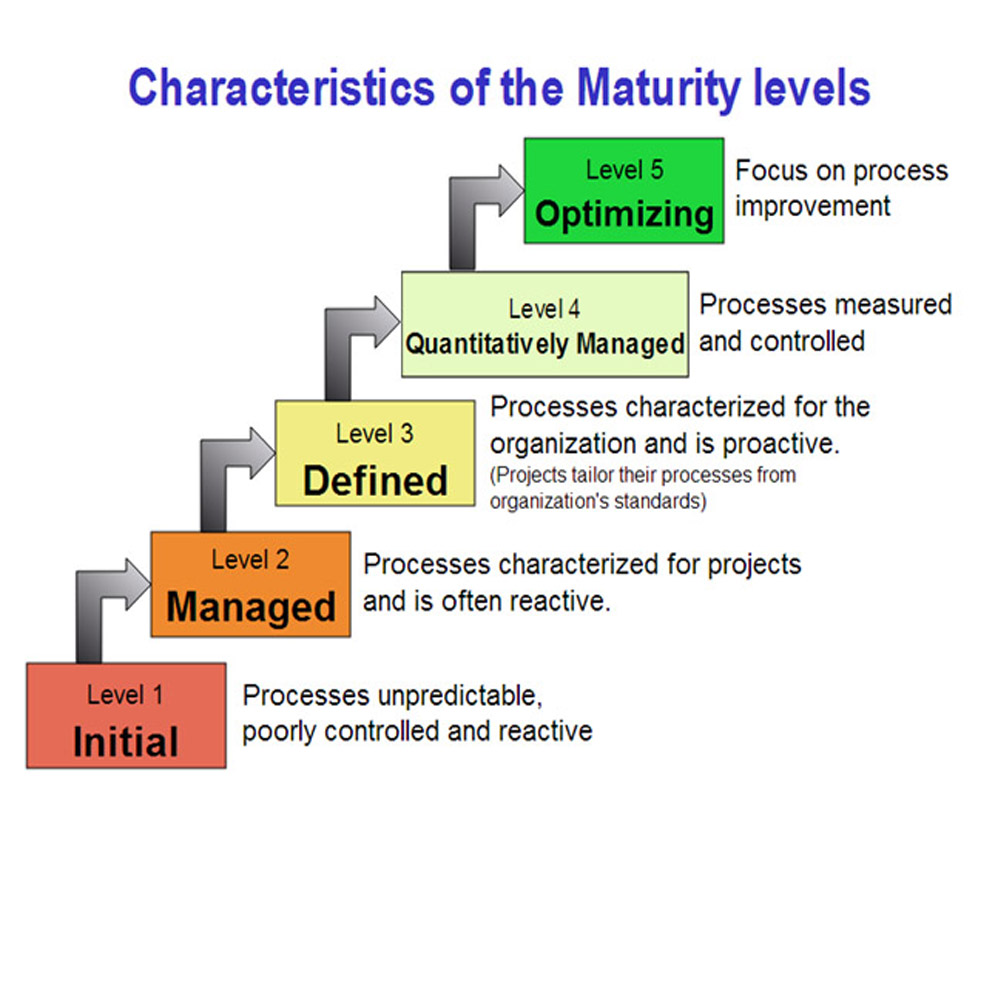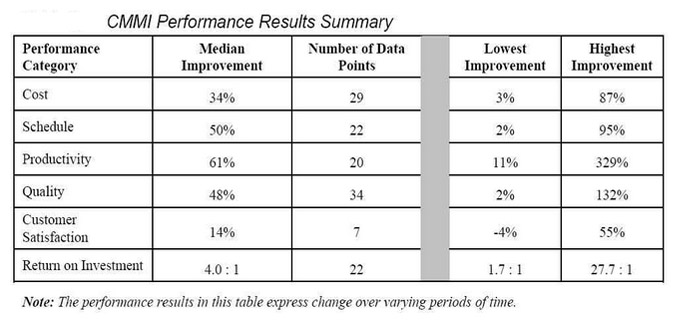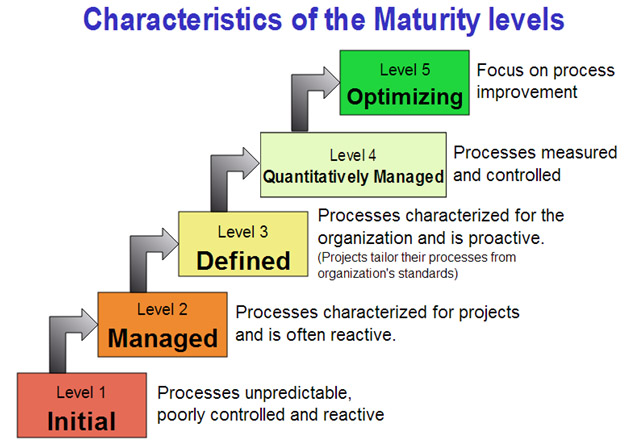Capability Maturity Model Integration
CMMI
The quality of a software product is only as good as the process used to develop and maintain it. Whether a software organization is competing in the marketplace or trying to satisfy internal requirements, its software process is a critical success factor. Well thought out improvements to the process will significantly contribute to the organization’s performance.
Capability Maturity Model Integration (CMMI) is a process improvement training and certification program and service administered and marketed by Carnegie Mellon University and required by many DOD and Government programs for government contracts, especially software development. Carnegie Mellon University claims CMMI can be used to guide process improvement across a project, division, or an entire organization.
Some interesting Stats
There are over 5,000 businesses that use CMMI models from over 70 countries, including the U.S., China, Germany, Italy, Australia, India, Turkey, Pakistan, Egypt,Chile, and Russia.


A research by University of Missouri – St. Louis IS6840 – Fall 2008
Top 6 Benefits Of Adopting CMMI Quality Framework?
CMMI not only rates the maturity of companies’ process, it gives a level of assurance that the company being given the work will be able to complete the job in the time and price quoted for the project.
In order for the local software development industry to become more competitive on a global scale, it will need to fall into line with international standards, so that local companies seeking international contracts will be able to meet the CMMI level specified by international companies.
Having originated in the US defense sector, CMMI is now being adopted increasingly widely to drive Business Improvement in diverse organisations.
1– Consistency
CMMI provides a proven approach that has enabled diverse organisations to drive out real benefits in terms of dramatically improved project predictability and consistency. Whilst any or all of the above factors may drive an organisation’s initial interest in CMMI, the key benefit from implementing the model that executives focus on is consistency in delivery.
2– Cost Saving
CMMI driven process improvement also delivers real cost savings such as earlier and more effective error detection, and hence reduced cost of remediation, more effective management of change so you spend less on re-work, reductions in schedule variability and increased cost predictability.
3 – Self Improvement
There is also the aspect of self improvement. Companies will be able to use CMMI as a way of differentiating themselves locally and by achieving a level of CMMI will have naturally improved their processes which will make them more competitive. The heat of competition is now driving significant interest in CMMI. Development, Service Provider and Acquisition/Outsourcing organisations are all adopting CMMI both as a differentiator and as an enabler to enhanced performance.
4 – Market demand
Competing companies are utilizing CMMI for industry best practices and reaping the benefit of it. Companies have adopted this approach to best meet the customer demands and competition. —Growing popularity of CMMI in the market is also a big reason of adoption of this practice by companies.
Subcontractors providing custom software to companies creating solutions for the federal government must either themselves be following CMMI, or be covered by their client. All the parts of the software product delivered to the government must be following CMMI somewhere in the supply chain.
5– Performance demand
The purpose of CMMI is to improve upon the performance of the existing organizational standards, processes and procedures and NOT to redefine or them.
CMMI is meant to help organizations improve on their “capability” to consistently and predictably deliver the products, services, and sourced goods their customers want, when they want them and at a price they’re willing to pay.
CMMI can be applied to create a process improvement solution appropriate to the context of each unique organization and can provide a path for an organization to achieve its performance goals.
6– Process improvement
A CMMI driven improvement project will deliver a framework to standardize your processes, ensuring that your business’s best practices are captured, shared and adopted so that you can move staff around your organization and leavers won’t take business critical information away with them.
CMMI includes 25 different process areas to cater comprehensive business process improvement solution. —Each process area is made of two kinds of goals, two kinds of practices, and a whole lot of informative information helping management to make strategies.
Why Use a Model?
Without a model of how an organization work, which functions it need, and how those functions interact, it is difficult to lead efforts to improve. A model gives us an understanding of discrete elements in an organization and helps to formulate language and discussion of what needs to be improved and how such improvement might be achieved. A model offers the following benefits:
Provides a common framework and language to help communicate
leverages years of experience
Helps users keep the big picture in mind while focusing specifically on improvement
Is often supported by trainers and consultants
can provide a standard to help solve disagreements
Characteristics Of The Maturity Levels
Under the CMMI methodology, processes are rated according to their maturity levels, which are defined as: Initial, Repeatable, Defined, Quantitatively Managed, Optimizing. Currently supported is CMMI Version 1.3. CMMI is registered in the U.S. Patent and Trademark Office by Carnegie Mellon University.

CMMI Model Framework
3 Constellations are defined to help improve a given business need. Currently there are three (3) constellations:
Development: For improving the development of solutions.
Acquisition: For improving the purchasing of products, services and/or solutions
Services: For improving delivery of services and creation of service systems (say, to operate a solution but not buy it or build it in the first place).

Maturity levels in CMMI for development
There are five maturity levels. However, maturity level ratings are awarded for levels 2 through 5. The process areas below and their maturity levels are listed for the CMMI for Development model:
Maturity Level 2 – Repeatable
Maturity Level 3 – Defined
Maturity Level 4 – Quantitatively Managed
Maturity Level 5 – Optimizing
Maturity levels in CMMI for services
The process areas below and their maturity levels are listed for the CMMI for Services model:
Maturity Level 2 – Managed
Maturity Level 3 – Defined
Maturity Level 4 – Quantitatively Managed
Maturity Level 5 – Optimizing
Maturity levels in CMMI for acquisition
The process areas below and their maturity levels are listed for the CMMI for Acquisition model:
Maturity Level 2 – Managed
Maturity Level 3 – Defined
Maturity Level 4 – Quantitatively Managed
Maturity Level 5 – Optimizing
Summary
A high maturity organization where all individuals recognize their role and responsibility for business success is an organization that is more likely to achieve success.
What an organization gets out of process deployment and CMMI appraisals is a reflection of what the organization puts into it. Organizations that focus on a just wining the CMMI certification hardly find the real benefits of adopting the quality framework.
High maturity, with its focus on quality and process performance objectives, puts organizations and projects in a position to succeed.
